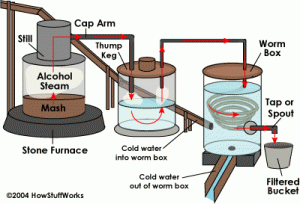Humans have been making, using, and consuming alcohol since the dawn of civilization. It first began with the cereal grains used to make beer by the cultures of Mesopotamia and Egypt. Later, the cultures of the Mediterranean–the city-states of Greece and the Roman Empire–adopted wine as an integral part of social, political, and religious life.
The Age of Exploration starting in the 15th century gave birth to a new range of spirits thanks to the improvement and growth of the distillation process. Drinks like rum, whiskey, and brandy were used as currency to buy slaves in the colonies of the New World. Eventually, these same spirits played a major role in the formation of the United States.
In today’s times, alcohol is more than just a thirst quencher, religious symbol, or bartering agent. We now use alcohol as a disinfecting antiseptic, chemical solvent, in products like antifreeze, and as fuel. With such versatility, alcohol is one product whose demand will increase exponentially in the event of a disaster.
Thus, learning how to make your own alcohol can be an incredibly gratifying and potentially life-saving way to spend your time prepping. Doing so could yield an unlimited supply to be used for personal consumption, medical use, sterilization, fuel, and trade. If using a homemade still you can also create distilled water, another multipurpose survival substance.
The components for making alcohol are actually quite simple. Alcohol is made when yeast is added to a sugar-containing substance, which releases CO2 and starts the fermentation process. In wine, yeast is added to a grape mixture to ferment the natural sugars over time.
 The process is slightly more complicated in beer, as grains don’t contain as much natural sugar. Thus, the grain-growing process is halted midway to harness the sugar enzymes and “malt” the grain before yeast is added.
The process is slightly more complicated in beer, as grains don’t contain as much natural sugar. Thus, the grain-growing process is halted midway to harness the sugar enzymes and “malt” the grain before yeast is added.
Hard liquor requires the additional step of distillation, which serves to concentrate the liquid AFTER the fermentation process of a “mash” of corn or fruit.
Though the process is labor intensive, making your own beer and wine is perfectly legal. In fact, homebrewing has taken off as a hobby around the world in recent years.
You can purchase a kit with everything you need to get started or do it from scratch with your own materials.
Unfortunately, distilling alcohol remains illegal for personal use and distribution (in the United States) for reasons of safety, taxation, and regulation. However, distilled ethanol, or grain alcohol, is the most versatile and useful form of alcohol for survival purposes.
Ethanol is a clean burning fuel that can power your vehicle and be used as fuel for cooking or lighting. In fact, it was once mixed with turpentine as an alternative to whale oil for 19th century street lamps. Accordingly, ethanol mixes well with kerosene to allow for an extended supply.
If dehydrated properly, ethanol can also be added to unleaded gasoline to extend its life. If you face a scenario where the supply of gasoline is exhausted, ethanol could also be used to make your own E85.
The supplies and purification process are complicated, but this homemade fuel could be created for less than what you’d expect to pay at the pump.
Another benefit of ethanol is its extended shelf life. If stored in an airtight container, ethanol can retain its potency for years. If stored in your garden-variety lawnmower gas can or other open-topped container, ethanol will become less stable as a source of fuel.
Additionally, alcohol makes great fuel for cooking. Homemade tin can alcohol stoves are something every prepper should know how to make and carry in their bug out bags as a back up fuel source.
The basic process for making homemade ethanol alcohol is as follows:
Mash
Distilled ethanol alcohol starts with a mash. Corn is commonly used, as it is inexpensive and readily available. However, pretty much any compost material could be used granted it contains the right enzymes to react with yeast to break down the sugars. These could be potatoes, carrots, sugar cane, or any other starchy produce.
You typically start with equal parts mash starch and sugar in a five-gallon bucket with filtered water added until full. A few packets (recipes and amounts vary) of yeast is added and stirred until (roughly) dissolved.
Fermentation
The mixture in the bucket is then covered and left to sit for 2-3 days (or longer). The lid should not be opened at any point during this time.
If you would like a one-way vent, you can drill a small hole in the bucket of the lid. Then tape a surgical glove (or balloon) around the hole and poke a small pinhole in the tip of one of the fingers. As the mash ferments you will see the fingers of the glove (or balloon) partially inflate.
After 3 days, agitate the mixture by shaking the bucket without removing the lid. The mash should be ready after 4-5 days when the sediment rests at the bottom of the bucket and is no longer partially suspended. This is a sign the yeast has completed fermenting the sugars into alcohol.

Distillation
The distillation process requires boiling your mash, condensation of the liquid, and cooling and collecting the vapor. Ideally, this will be done in some kind of still.
Popular homemade versions are Reflux and Fractionating stills, typically used to make neutral, or tasteless, ethanol alcohol that can be used straight up or flavored for consumption later.
The alcohol will begin to boil off at about 170 degrees Fahrenheit. The outlet of your still should cool the vapors down to about 70 or 80 degrees and turn the ethanol back into liquid.
As the alcohol levels of the mash are boiled off and reduced, the temperature of the pot will begin to rise.
Once your mixture reaches about 220 degrees it is finished producing ethanol and a new batch of mash will need to be added.
While anyone can learn how to make homemade beer or wine, distillation is a bit more difficult. Yet with so many uses both in times of peace and crisis, knowing how to make homemade alcohol is a lifesaving skill no prepper should be without.
This article has been written by Cody Griffin for Survivopedia.






































































Is there a way to breed the yeast so as to have a supply that doesn’t require you to buy more periodically?
Thanks!
I don’t know if ‘wild yeast’ would work, but common ‘sour dough’ breads use wild yeast captured from the air and grown in potato “starter” (among others). Starters begin with purchased yeast then are added flour & liquid each time you make bread for a never ending supply. Does anyone know if this kind will work for ethanol?
Yes, wild yeast can be cultured to ferment.
The down-side is having enough yeast to ferment 5 gallons of wash / mash which after being distilled will leave you with about 1 gallon of Fuel that is suitable for cooking or burning in some way.
This article is an outline and so it doesn’t give enough details to either get E85 car fuel or enough detail to make Antiseptic quality alcohol, and certainly not enough detail to make anything that should be consumed by people.
What this article is good for, is to get the reader aware of alternative methods of survival and it is left to the reader to obtain the facts for themselves.
As a side note, you can stock up on bread yeast at the grocer but even when refrigerated it still has a shelf life of ~1 year (ish).
Thanks for the suggestions everyone. My ultimate goal is to produce drinking alcohol (imagine that). I know bread yeast isn’t the right kind for beer, and I don’t think for other drinking purposes as well. When I was a teenager I attempted making a drinking alcohol mixture by simply adding sugar to water and dumping in some bread yeast. It did produce some alcohol, but it also made enough vinegar to make it unpalatable at the same time. Of course, that didn’t stop me from trying to drink it, being a teenager and all :-).
Not sure if you’ll see this, but what you can do is take a sample from the beer, wine, etc you are making prior to racking/bottling it. Usually you keep a bit of the strub at the bottom and a bit of the beer, for example, and you’ll add this to the next batch or keep it for a few days (I use a mason jar). There will still be live yeast suspended in the beer mixture and when you add it to the next batch they’ll pick up where they left off. You can do this over and over.
If anyone is interested in making ethanol, you might check out David Blume’s tome, Alcohol Can Be a Gas. Check your library (system). They may have a copy you can peruse for free. It’s very comprehensive (maybe a little too much so). Ethanol is also carbon neutral (for those with environmental concerns). One item I would like to point out is that distilling alcohols can be legal if you obtain a license/permit from the ATF.
Yeah, I’m pretty sure you can distil up to a certain gallon amount per year with your own distiller but only for personal use. And then, like getting an FFL you have to get the license if you want to go commercial and jump through costly hoops like any other business. But they have some nice personal distillers now that work on electricity, propane, or even wood. And they are NOT illegal to own because a distiller can also be used just to make ‘distilled water’.
And of course you won’t see many ATF agents out searching around to crash anybody’s small home stills to see how much they’re making in a real SHTF situation, now would you? LOL!
I have been making fuel alcohol for a couple of years with a legal Federal license. You do not need yeast. Simply put some corn in a burlap bag, wet it and let the sprouts grow a couple of inches. Dry and grind and add to your mash. Old timers used this malted corn to make the finest drinking stuff, Illegal now of course. Look at Milehidistilling. Don’t expect real cheap. About the best I have been able to do is $8 a gallon. with corn, rye and sugar. It is a blast to do just to prove you can.
Well, hell, Bob, I’ll trade you some dried Shitaki mushrooms, some alternative meds, maybe even some ammo, if that stuff is as good as you say it is, LOL!
And 8 bucks a gallon is pretty cheap actually when you consider that EVerclear 190 proof grain moon shine is pushing 15 bucks a quart? And you can’t drink thatt straight so it’s reall more than two gallons of sippin shine for 8 bucks?
The diagram of your thumper is wrong, that would be ok as a lobber box, but good for nothing else.